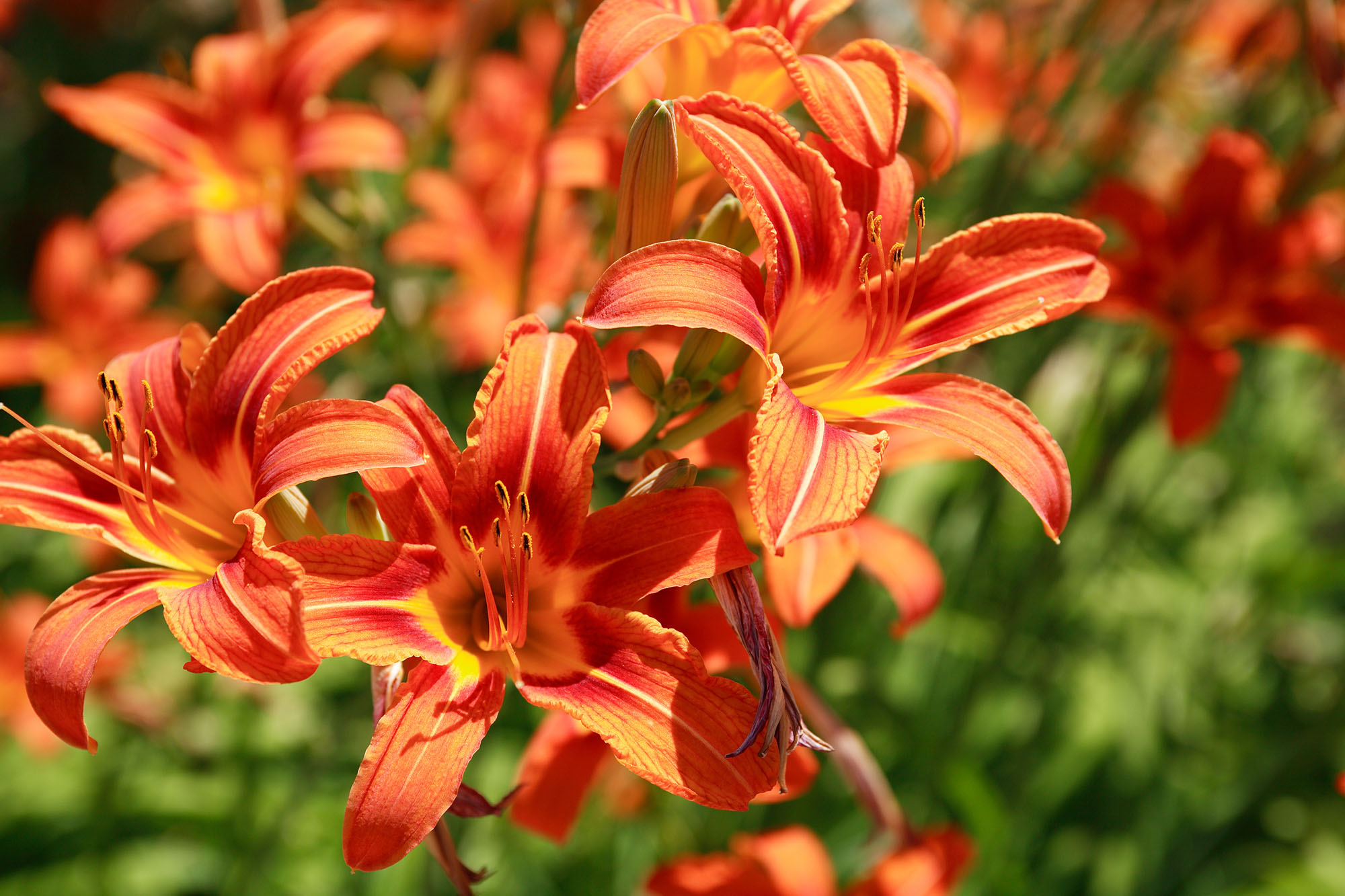- © 2026 Annapolis Home Magazine
- All Rights Reserved
By Kymberly Taylor

Consider the lilies, how they grow: they toil
not, neither do they spin; yet I say unto you,
even Solomon in all his glory was not arrayed like one of these.
Matthew 6:28
The common daylily, Hemerocallis fulva, is beautiful, easy to grow and propagate, and, lucky for Marylanders, drought tolerant. Thousands of years old, this beloved perennial that originated in China and East Asia has been cultivated for both medicinal purposes and food from its buds and roots. Scholars speculate that daylilies were brought to Europe in the 1500s, perhaps along the Silk Road, which connected the Far East to commerce in the West. Most likely, early European immigrants brought the orange or tawny daylily to our shores, packing the roots along with other treasured possessions for the arduous journey to the New World. By the early 1800s, the carefree plant had spread freely through rhizomes and its underground root system. Easy to maintain, the brilliant orange clump of flowers adorned many homestead gardens.
Though they originated in China and East Asia thousands of years ago, daylilies certainly thrive here, as if Maryland were their second home. Their cheerful orange blossoms have been with me every summer of my entire life, it seems, hovering at the edge of my peripheral vision and seeping into my consciousness. Because I saw them blooming everywhere like weeds—alongside barns, in roadside ditches, cemeteries, and pastures—I used to dismiss them. However, as my garden wilted before my eyes in the scorching July heat, there they were—bold, beautiful, and as fresh as ever on a 100-degree day. I had to reverse my opinion!
For the first time, I looked closely at the huge trumpet-shaped blossom that closes at night and dies, to be replaced the next day by a new bloom. I saw a four-inch trumpet-shaped flower flooded with the colors of the setting sun, with a touch of yellow in the center. I noticed that some daylilies have ruffles with tangerine petals that fold forward, revealing shy streaks of apricot. These are called “angel’s wings” according to the dictionary of the American Daylily Society.
Such effortless beauty reminds me of a verse from the gospel of Matthew: “Consider the lilies, how they grow: they toil not, neither do they spin; yet I say unto you, even Solomon in all his glory was not arrayed like one of these.” Lately, I have begun to see this heavenly perennial everywhere. In fact, on a recent visit to The Inn at Perry Cabin, vigorous clumps seemed positively airborne, flanked on either side by tall curvaceous grasses. The five-foot beauties were layered right into the lush gardens surrounding the majestic historic inn. The common daylily, still seen growing wild on the edges of forests and hillsides, has certainly migrated to our backyard gardens. And when intermixed with other plantings, it is an uncommon, standout specimen.
For this profusion of daylilies, we have Dr. Arlow Burdette Stout to thank. A. B. Stout (1876-1957) was a research scientist, geneticist, and specialist in daylily hybridization. As a child, he became obsessed with a tawny daylily his mother had planted by the porch of their Wisconsin home. Why didn’t it produce seeds? he wondered. His curiosity about how it reproduced sparked a lifetime of scientific study, breeding, and, eventually, the evolution of the modern daylily.
Stout pursued his studies in botany, earning a Ph.D. from Columbia University. In 1911, at the age of 35, he joined the staff of the New York Botanical Gardens, where he spent almost four decades experimenting with extensive breeding programs. The seeds and plant species he obtained from the Far East resulted in some 50,000 crosses and hundreds of thousands of seedlings. During his tenure, Stout introduced approximately 100 cultivars, many of which are still widely grown today. For his outstanding contributions, he was awarded the title “The Father of the Modern Daylily.”
Dr. Stout’s devoted research paved the way for other enthusiasts. From a handful of hybridizers at the turn of the century, we now have thousands of breeders who have created over 48,500 cultivars that vary in color, texture, form, and size. Fortunately, we can still learn directly from Dr. Stout, as he published his findings in a definitive text called Daylilies (1934). This prized volume, reprinted by Sagapress, Inc. in 1986, still remains highly praised by hybridizers and backyard gardeners alike.
Daylilies grow best in full sun and soil amended with a bit of compost. For a dramatic showing, plant them in groupings of six. Dig a hole twice as wide and just as deep as the plant’s root system. Ensure the crown (where roots meet the stem) is at or slightly below the soil surface. Fill the hole with soil and water thoroughly. The flowering period of an established clump is usually several weeks long. Many cultivars have more than one flowering period! Although not required, you may “deadhead” spent blooms each day so the plantings look clean and new blooms can open unobstructed.
I am planting daylilies—at least 18—in my garden straightaway; I have the perfect spot, right next to my chicken coop. As August descends, I will treasure their history, elegance, and resilience, along with their beauty that lights up our forgotten and found spaces with the colors of the summer sun as it sets and rises each day.
Interesting Fact: The forward facing ruffles on this daylily are called “angel wings,” according to the dictionary of the American Daylily Society.
In addition to her role as Editor-in-Chief of Annapolis Home and her love of plants, Kymberly is a poet whose new book, Thinandflyingdress, is available on Amazon.
© Annapolis Home Magazine
Vol. 16, No. 4 2025